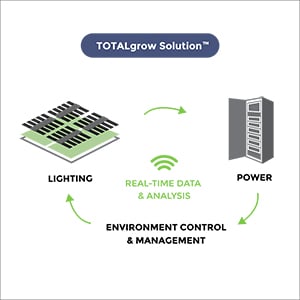Controlled environment agriculture is driving the cutting-edge of 21st century farming and growing techniques. In every sci-fi movie and show, the future is fed by a series of indoor and outdoor controlled growth operations to maximize efficiency in resources, time, yield, and quality. Monitoring these indoor grow operations (vertical, greenhouse, and indoor growing rooms) is crucial to maximizing each grow cycle's quality and quantity.
The Development of Cultivation
Crop quality and quantity are affected by the following factors:
 Temperature
Temperature- Nutrient concentration
- Nutrient pH
- Light
- Humidity
- Carbon dioxide
- Pests
An imbalance in any of these factors (or, in pest's case, an inability to control them) will degrade crop quality and quantity. For nearly all of humanity's experiments with farming, many of these factors were outside of the farmer's control. Farmers adapted by growing crops in certain regions, rice in the American South, root vegetables in the United Kingdom, millet in Northern China, etc. It wasn't possible to grow good tobacco in Canada because the temperature and humidity were not ideal.
Furthermore, rather than measuring nutrient concentrations of the soil, farmers relied on past practices and crop quality to gauge the soil's remaining nutrient concentration before rotating to a different crop or allowing a field to go fallow for a few seasons.
Such was the world in which farming existed for thousands of years until the introduction of monitoring equipment, sensors, and computers capable of processing vast amounts of data and converting it into reports that humans can understand.
Environmental Monitoring
Environmental monitoring takes the guesswork out of farming. It allows farmers to maximize their crop potential every growth cycle. Hydroponics, aquaponics, and other modern farming techniques allow farmers to precisely control the water and nutrients that plants absorb. Farmers can use sensors to measure the light received by plants from LED lighting, ensuring maximum growth potential. Humidity sensors ensure that plants are kept in the optimum environment to maximize quality.
While the up front costs of Controlled Indoor Agriculture solutions can be high, these upfront costs deliver farmers rapid returns on their investments several times over. A study highlighted by Science Illustrated found that indoor cultivation paired with monitoring technologies and LED lighting can produce 20 times as much food as a similarly-sized plot of soil. These modern growth operations will likely be necessary to meet the growing global population.
Environmental Benefits
Finally, an efficient indoor operation or greenhouse reduces the climate change problems associated with traditional farming. Indoor operations use the precise amount of water needed to sustain their operations, reducing water waste. They use efficient LED lighting to deliver the precise amount of photons while minimizing electricity usage. Most importantly, controlled environment agriculture can significantly reduce or eliminate pesticide use as the indoor operations provide much greater control and safety for crops from pests.
If you're managing an indoor cultivation project, you will benefit from TSRgrow LED lighting and its TOTALgrow™ Solutions that empower farmers in all areas of controlled environment agriculture. Built on its Lighting as a Platform™, TSRgrow remote power server technology delivers 100% tunable power for precise DLI control while monitoring and reporting all aspects of the environment, improving quality and yields of every grow cycle. To learn more, visit www.TSRgrow.com or contact a growing specialist today.
